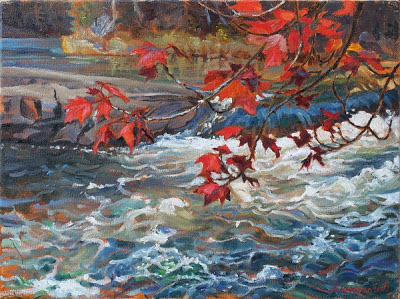Bolete Under Pines (oil on canvas 5 x 7 in.) SOLD!
11 October finds us looking for Wood Frogs in Limerick Forest, east of Bishops Mills Ontario. We have walked back into the Red Pine plantation behind the "Chalet" building - pines that were planted in the 1940s to stabilize blowing sand after farming failed in the area. At this time of year the Wood Frogs are leaving the sunny open spots in the woods where they have been hunting for insects all summer, and heading for low, moist spots where they will hide in the leaf litter, raising their blood sugars in order to survive freezing solid for the winter.
A Spring Peeper practices for spring, emitting a volley of lusty peeps from somewhere unseen while Fred and Philip sneak around among the dry ferns and leafless Viburnum and invasive Shining Buckthorn, looking for movements of brown, gold and copper Wood Frogs among the brown, gold and copper fallen leaves, I am finding mushrooms, creeping about on my hands and knees to photograph them.
First I notice a tall Amanita mushroom with a gleaming egg-shaped cap flakey with the white scraps of its old veil, and then begin finding more and more brown Boletus with their soft suede caps and spongy porous undersides. This one still wears the fallen pine needles that it pushed up as it emerged from the fine network of mycelium that fills the forest floor, breaking down buried rotting wood and feeding the trees.
First I notice a tall Amanita mushroom with a gleaming egg-shaped cap flakey with the white scraps of its old veil, and then begin finding more and more brown Boletus with their soft suede caps and spongy porous undersides. This one still wears the fallen pine needles that it pushed up as it emerged from the fine network of mycelium that fills the forest floor, breaking down buried rotting wood and feeding the trees.
We will take some of them home for Fred to identify, and then to add to supper. Neither the bolete (which Fred recognizes as a Leccinium) nor the Amanita compare well to the species described in the field guide, so we decide to leave the Amanita because many of them are poisonous, and keep the Leccinium because none of them are poisonous.
Most "boletes" are edible, but we always check their identities anyway. The flesh is very soft when cooked, with a texture like raw liver. This is surprising to those who are used to the rubbery consistency of gilled mushrooms, but I find them quite tolerable in casseroles and thick stews, and of very good flavour.




This makes me think of "Warty Bliggens the Toad" in the book "Archy and Mehitabel"! Warty Bliggens believes the world was created for his benefit, especially mushrooms, which keep him dry at night and provide shade for him by day.
ReplyDeleteIt's a beautiful picture. I never fail to be impressed with all the detail you fit onto a 5x7 canvas.
There's evidently a reason why the field guides fail us in this instance. Leccinum is pretty easy to identify to genus. "But while recognizing that a bolete is a Leccinum is usually relatively easy, figuring out what species you have found can be truly frustrating. In fact, if you are a North American collector at this point in time, it is probably not possible to identify most Leccinum species with scientific certainty." - http://www.mushroomexpert.com/leccinum.html - because the relationships between gross and microscopic morphology, DNA, and mycorhizzal partner Plants have only been worked out in a few cases.
ReplyDeleteAlso, Aleta doesn't mention that the stipes of many of both the Amanita (cf muscaria) and the Leccinium were hollowed and riddled by gorgeous orange-with-stripes Arion subfuscus slugs. You can see some nibbles taken from the cap of the one in the painting, and some holes bitten into the base of the stipe (these latter staining a little blue, as the flesh of the stipes was wont to do) by the slugs. I suggested that she title the painting "Slug-bitten Bolete," but Under-the-Pines won out.
ReplyDeleteIt has a beautiful 3-D feeling to it -- it's a painting of a mushroom-capped space!
ReplyDeleteKaren